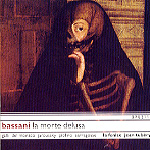Most listeners’ and performers’ experience with the Italian Baroque is primarily confined to the big names–Vivaldi, Corelli, Scarlatti, even Tartini–and only occasionally ventures into the less-traveled territory of composers such as Marcello, Marini, Vitali, Stradella, or the one featured here, Giovanni Battista Bassani (1657-1716), a relatively important figure in Ferrara, where he served as the cathedral’s maestro di cappella. This oratorio, which in its near-exclusive reliance on arias and recitative displays many of the dramatic characteristics of opera, was composed in 1686 as a tribute to those who died “in the Christian enterprises against the Turks” in 1683. Characteristic of many similar works of the period, its theme (the title means “Death confounded”) concerns an allegorical interaction among five characters–Death, Glory, Piety, Justice, and Lucifer–in which Death laments its powerlessness against the forces of Piety and Glory, who, along with Justice have assured the departed souls of the holy warriors an eternal existence in heaven.
The five singers–soprano, female alto, countertenor, tenor, and bass–make up the entire cast, twice joining together for ensembles at the end of Part 1 and Part 2. A very small instrumental group, consisting of violins and continuo (cello, lute, bassoon, organ, and/or harpsichord) and an occasional cornett accompanies the voices and goes solo for the two Sinfonias that open each of the work’s two major sections. The music is pretty standard stuff, the primary interest being Bassani’s vivid if predictable characterizations, from the very testy Morte (Death) and distraught Lucifer, to the oh-so-sweet Piety. The voices are all decent–soprano Emanuela Galli and countertenor Philippe Jaroussky are particularly fine–although alto Daniela del Monaco’s hard, forced quality sounds just plain uncomfortable (arguably a perfect representation of Death, I suppose). Instrumental playing is consistently energetic and very closely in sync with the singers in tempo, phrasing, and inflection. The sound is relatively close, the perspective too narrowly focused and lacking desirable vibrancy. Specialists will be interested; others will likely wonder what the fuss is about.
































